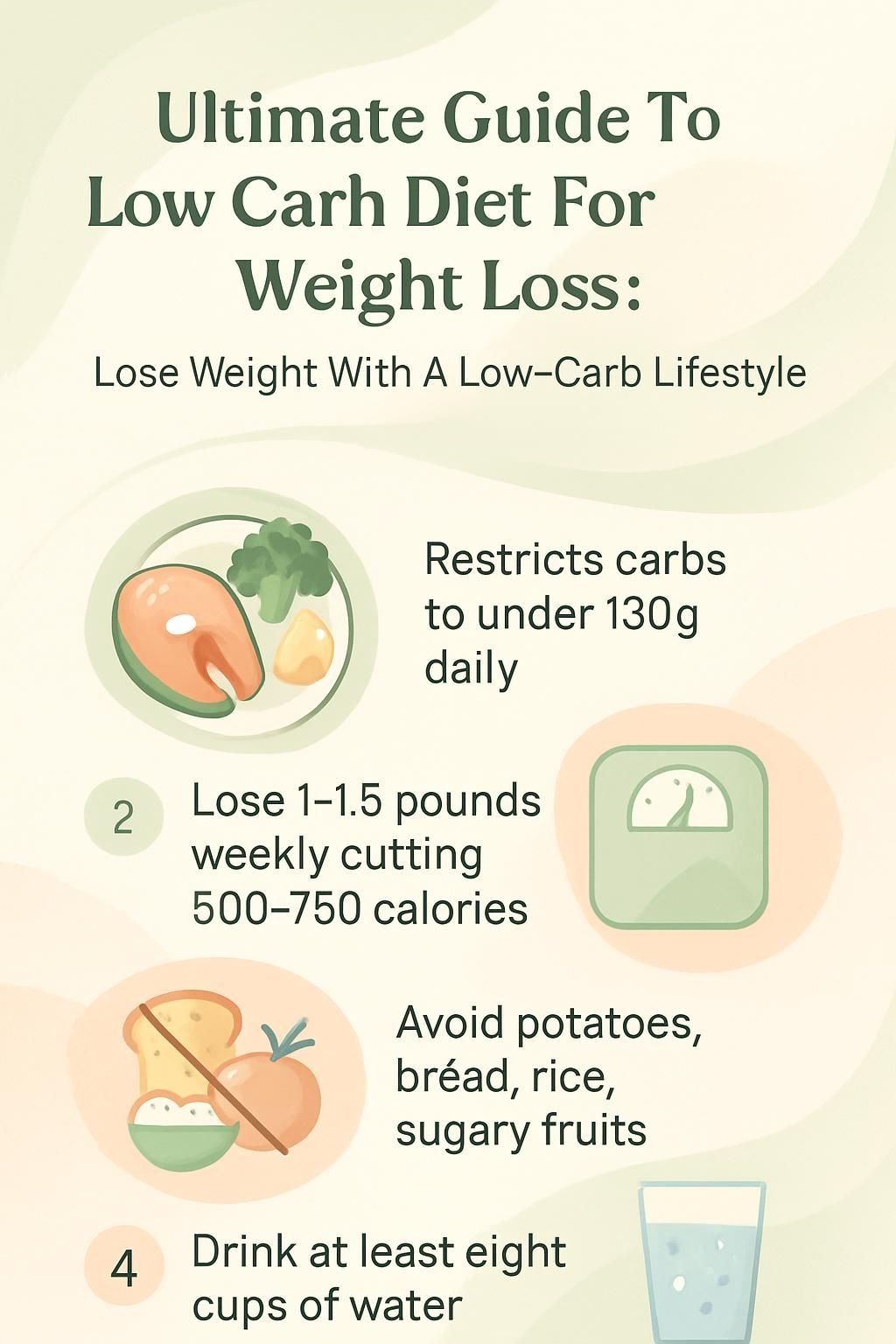Ultimate Guide To Low Carb Diet For Weight Loss: Lose Weight With A Low-Carb Lifestyle
Our Nutrition Assistant AI Suite will transform your body. You will lose fat, get toned, and build muscle. Gain confidence and optimal health.
You work hard to lose weight, yet the scale can stall. A low-carb diet limits sugar and starch, helping you control hunger and trim calories without feeling deprived.
This guide gives you clear steps, practical meal plans, and plain-language science on carbohydrates. Use it to make small changes that add up to steady progress.
Key Takeaways
- A low-carb diet typically keeps carbohydrates under 130 grams per day and centers meals on lean protein, healthy fats, and non-starchy vegetables.
- Many adults lose about 1 to 1.5 pounds per week by cutting 500 to 750 calories daily on a low-carb plan, and often see better blood sugar control.
- Popular approaches include keto at 20 to 50 grams of net carbs per day, Atkins, and South Beach. These may lower triglycerides and stabilize insulin, though long-term data are limited.
- Avoid potatoes, bread, rice, high-sugar fruits such as bananas and grapes, and processed snacks with added sugars since they spike glucose.
- Plan meals, build vegetable-rich breakfasts like eggs with avocado, drink at least eight cups of water per day, and keep food choices varied and nutrient dense.

Understanding the Low-Carb Diet

A low-carb diet limits foods high in carbohydrates and highlights protein, healthy fats, and non-starchy vegetables. Many people use this approach for weight management and to improve blood sugar.
What Is a Low-Carb Diet?
Low-carb eating reduces foods like bread, pasta, rice, and sugary snacks. You shift your menu to protein and fat, such as chicken, fish, eggs, cheese, nuts, seeds, and olive oil.
Many plans allow fewer than 130 grams of carbs per day on a 2,000-calorie diet. That is less than 26 percent of daily calories from carbs.
The ketogenic diet is a stricter type that limits you to 20 to 50 grams of net carbs per day. Atkins and South Beach are also low-carb methods. The Dietary Guidelines for Americans suggest 45 to 65 percent of calories from carbs, which is much higher than most low-carb plans.
You can often steady blood sugar with a well-planned low-carb approach.
Some people begin lower, about 20 to 50 grams per day, then add carbs slowly. This style suits many adults with excess weight or type 2 diabetes who want an option besides a higher-carb diet.
How Does a Low-Carb Diet Promote Weight Loss?
Cutting carbs nudges your body to use stored fat for energy instead of glucose from carbs. This process is called ketosis, which means your liver makes ketone bodies as an alternate fuel.
Early weight loss can be faster than with a low-fat diet. Many adults lose about 1 to 1.5 pounds weekly if they also reduce total calories by 500 to 750 per day.
Higher protein and fat help you feel full longer, so you eat fewer calories. Lower insulin levels can reduce fat storage, which is helpful if you live with obesity or diabetes.
What Are the Benefits of a Low-Carb Diet?
A low-carb diet can support weight loss and offer health benefits in the short term. Evidence is strongest in adults with overweight or with diabetes.
How Does It Speed Up Weight Loss?
Fewer carbs push your body to burn fat for fuel. Studies show greater early weight loss in the first months compared with low-fat plans.
One trial found adults with obesity lost about 8 to 10 pounds within two months on a low-carb plan. Meals rich in protein and fat, such as eggs, chicken, avocado, and nuts, also reduce appetite and help you cut calories without white-knuckle hunger.
Staying away from processed foods and refined starches helps steady blood sugar. Fewer spikes mean fewer cravings, which supports long-term success.
Can It Lower Insulin Levels?
Carbohydrates break down into sugar, which raises insulin, the hormone that moves sugar into cells. Limiting carbs can lead to lower insulin levels and lower fasting glucose.
People with type 2 diabetes often see improved blood sugar control and may need less medication under medical supervision. As you reduce total carbs, your body shifts to burning fat instead of storing it.
Lower-carb diets can reduce both circulating glucose and insulin in many adults.
That shift may lower risk factors and support weight loss, especially when your meals include fiber-rich vegetables and lean protein.
How Does It Help Control Hunger and Cravings?
Protein and healthy fats increase fullness. Foods like eggs, chicken, avocado, and nuts digest slowly, which helps curb frequent hunger.
Limiting added sugars and refined grains prevents rapid blood sugar swings that cause cravings. With steadier energy, you spend less time thinking about snacks.
Many people find that simple low-carb meals, for example a chicken salad with olive oil, keep them satisfied for hours and reduce snacking.
Does It Improve Blood Sugar Stability?
Replacing refined carbs with whole, low-carb foods helps keep your glucose steady after meals. This is helpful if you have prediabetes or type 2 diabetes.
Complex carbs like vegetables digest slower than white bread or candy, which means fewer spikes. Studies report better fasting glucose and A1C, a long-term marker of blood sugar, when people limit daily carbs.
Simple breakfasts like eggs, avocado, and greens can give you steady morning energy. Many clinicians also observe lower insulin levels when patients focus on lean protein, non-starchy vegetables, dairy like Greek yogurt, and limited fruit.
These gains support weight loss and fit with guidance from major groups such as the American Diabetes Association when used within a full care plan.
Can It Boost Heart Health?
Short-term studies show lower triglycerides and higher HDL, the so-called good cholesterol, on low-carb plans. Choosing healthy fats such as olive oil, avocado, and nuts can support heart health.
Limit foods high in saturated fat like bacon and fatty steak. There is limited long-term evidence, so keep vegetables plentiful and focus on quality fats and proteins.
What Foods Should You Eat on a Low-Carb Diet?
The right choices make low-carb eating easier and more filling. Build meals around vegetables, protein, and healthy fats.
Which Non-Starchy Vegetables Are Essential?
Leafy greens such as spinach, kale, and romaine lettuce should anchor your plate. Alfalfa sprouts and crisp iceberg add volume without many carbs.
Broccoli, cauliflower, zucchini, asparagus, celery, mushrooms, and radishes are low in net carbs and high in fiber. Fiber helps you feel full and supports digestion.
These vegetables also deliver vitamins, minerals, and antioxidants. They fit well for people aiming to manage type 2 diabetes or excess weight.
What Lean Proteins Are Best: Chicken, Fish, Eggs?
Non-starchy vegetables bring fiber and micronutrients, but protein protects muscle during weight loss. Lean choices include skinless chicken breast, white fish such as cod or tilapia, and eggs.
Chicken provides about 31 grams of protein per 100 grams with little fat or carbs. Salmon adds omega-3 fats that support heart health with minimal carbs.
Eggs offer complete protein at about 1 gram of carb each. Choose grilling, baking, or poaching instead of breading or deep frying to keep carbs and calories lower.
What Are the Key Healthy Fats Like Avocado and Nuts?
Healthy fats help you stay full and satisfied. Avocados provide mostly monounsaturated fat and few carbs. Nuts such as almonds, walnuts, and pecans provide beneficial fats and minerals like magnesium.
Your body can use these fats for energy when carbs are reduced. High-fat dairy like cheese and Greek yogurt adds calcium and protein while keeping carbs modest.
Adding half an avocado or a small handful of almonds to lunch often prevents afternoon cravings without raising blood sugar.
Which Low-Carb Fruits Are Recommended?
Some fruits fit well in a low-carb plan. Raspberries, blackberries, and strawberries are lower in carbs and high in fiber.
Watermelon, cantaloupe, kiwi, peaches, clementines, and grapefruit can work in small portions. For example, a cup of watermelon has about 11 grams of net carbs, and half a grapefruit has about 8 to 9 grams.
Match portions to your daily carb limit. Berries are usually the safest pick if you aim to keep carbs low and manage blood sugar.
What Foods Should You Avoid on a Low-Carb Diet?
Certain foods make carb limits hard to meet. Steering clear of them keeps your plan on track.
Why Avoid High-Starch Vegetables Like Potatoes and Corn?
Potatoes and corn are rich in starch, which digests quickly into sugar. A medium potato has about 37 grams of carbs, and one ear of corn contains around 25 grams.
These choices can spike blood sugar, which can disrupt ketosis and slow weight loss. Many people feel more even energy in the evening after swapping them for non-starchy vegetables.
Which Grains and Bread Products Should Be Excluded?
Grains and bread products raise carbs fast. Skip wheat-based items such as white bread, whole-wheat bread, bagels, pasta, and tortillas.
Refined grains like white rice and white flour products add many carbs without much fiber. Two slices of white bread can add about 30 grams of carbs.
Breakfast cereals, crackers, pastries, cookies, muffins, and pancakes are usually high in carbs. Gluten-free bread made from rice or potato flour spikes blood sugar much like regular bread.
Dropping these items can support steadier glucose and protect against energy crashes later in the day.
What Sugary Snacks and Beverages Are Off-Limits?
Skip cookies, cakes, pastries, candy, and similar sweets. They contain added sugars and refined flours that raise blood sugar quickly.
Avoid regular soda, sweet tea, lemonade, and energy or sports drinks. These beverages deliver large amounts of sugar in a short time.
Many low-fat or diet products add sugar to improve taste. Check labels for corn syrup or cane sugar. After two weeks without these items, many people report fewer cravings and more stable energy.
Which High-Sugar Fruits Should You Skip?
Bananas, grapes, and mangoes are high in sugar and carbs. One medium banana has about 27 grams of carbs, and a cup of grapes has around 23 grams.
Pineapple and cherries can also raise blood sugar quickly. Choose berries instead if you want fruit with a smaller carb impact.
If you track net carbs closely or manage diabetes, limiting these high-sugar fruits helps keep glucose steady and cravings in check.
What Does a Sample Low-Carb Meal Plan Look Like?
A sample plan makes choices easier. Pair low-starch vegetables with protein and healthy fats, then adjust portions to your goals.
What Are Healthy Breakfast Ideas Like Eggs and Avocado?
Cook two eggs in olive oil. Serve with sautéed spinach and half an avocado for a filling start.
Scrambled eggs with bacon, a veggie omelet, or smoked salmon with avocado also work well. Almond flour pancakes can be an option, with about 11 grams of carbs for two pancakes, 12 grams of protein, and about 234 calories per serving.
These breakfasts tend to prevent mid-morning crashes and make it easier to focus.
What Lunch Options Include Grilled Chicken Salad?
Grilled chicken salad is a reliable pick. Combine three ounces of chicken breast with two cups of zucchini noodles for roughly 17 grams of carbs.
Add non-starchy vegetables such as leafy greens, cucumbers, and tomatoes. Choose full-fat dressing or olive oil for flavor without much sugar.
A lettuce wrap sandwich, sometimes called an unwich, adds variety. Pair with water or coffee to avoid sugary drinks.
What Are Good Dinner Choices Like Steak and Broccoli?
Steak and broccoli are a simple, low-carb dinner. A 6-ounce steak and one cup of steamed broccoli total about 8 grams of carbs.
A bunless burger with cheddar and broccoli also lands near 8 to 9 grams. For variety, try three ounces of chicken breast with Brussels sprouts and a small portion of quinoa at about 25 grams of carbs.
Slow Cooker Spinach Artichoke Chicken is another option, around 19 grams of carbs and 49 grams of protein per serving. These meals are satisfying without heavy starch.
What Snacks Fit a Low-Carb Diet?
Good choices include Greek yogurt, hard-boiled eggs, cheese sticks, and turkey or chicken slices. Nuts such as almonds or walnuts usually add fewer than 5 net grams per small handful.
Moderate portions of strawberries or blackberries work well. A few squares of dark chocolate at 70 percent cocoa or higher can satisfy a sweet tooth.
Leftover lean protein and avocado slices with a pinch of salt make quick savory snacks. Dry wines with no added sugar can fit within daily limits for social events.
How Can You Succeed on a Low-Carb Diet?
Daily habits decide results. Plan ahead, build simple routines, and make the easy choice the default.
How to Plan Meals for Convenience?
Batch-cook protein such as chicken, ground turkey, or eggs at the start of the week. Pre-cut non-starchy vegetables so salads and stir-fries come together fast.
Keep simple snacks on hand, like nuts and cheese. Many restaurants will let you skip bread and swap fries for vegetables. Ordering a bunless burger with extra greens is a quick example.
Planning reduces decision fatigue and helps you control carbs and calories, even on busy days.
Why Is Staying Hydrated Important?
Water supports energy, digestion, and kidney function. Low-carb eating can increase fluid loss, so you need to replace water and electrolytes such as sodium, potassium, and magnesium.
Choose water as your default drink. Many adults do well with at least eight cups per day; athletes may need more based on activity and heat exposure. Source: Mayo Clinic Staff, Water: How much should you drink every day, September 6, 2022.
Hydration helps prevent headaches, fatigue, and cramps while supporting stable blood sugar.
Why Avoid Processed Low-Carb Foods?
Packaged low-carb snacks often contain refined carbs and hidden sugars. These can spike blood sugar and trigger cravings later in the day.
Diets high in ultra-processed foods are linked in research to higher risks for heart disease and some cancers. Whole foods like eggs, avocado, poultry, fish, and nuts usually lead to steadier energy and better appetite control.
Choosing simple, natural ingredients also protects your intake of minerals like magnesium and potassium.
How to Ensure Dietary Variety?
Variety prevents boredom and nutrient gaps. Build meals with non-starchy vegetables, lean proteins, and healthy fats. Add low-carb fruits and rotate nuts and seeds.
Rotate protein sources such as chicken, fish, eggs, and small portions of legumes if your plan allows them. This supports muscle maintenance and a wider range of nutrients.
Switch up breakfasts, for example eggs one day, then Greek yogurt with flaxseed the next. Colorful plates often mean a broader mix of vitamins and minerals.
How to Overcome Challenges on a Low-Carb Diet?
Side effects and cravings can show up in the first weeks. Simple tactics shorten this phase and keep you on track.
What Is the Keto Flu and How to Manage It?
Strict carb cuts can lead to keto flu in the first week. Symptoms include headache, fatigue, irritability, muscle cramps, and bad breath.
These signs reflect your body switching from glucose to fat for fuel. Fluid and mineral losses often add to the discomfort.
Drink extra water, and consider adding electrolytes such as sodium, potassium, and magnesium from food or a supplement if your clinician agrees. Eat plenty of leafy greens for minerals. Reduce intense workouts until energy improves.
Most people feel better within a few days as the body adapts.
How to Handle Cravings Effectively?
Increase protein at meals to improve fullness and appetite control. Healthy fats from avocado, nuts, and olive oil also slow digestion, which delays hunger.
Drink a glass of water before snacking, since thirst can feel like hunger. Choose low-carb snacks such as cheese sticks or boiled eggs if you truly need food.
Plan your meals and keep your hands busy with a short walk or a task during craving windows. Preparation shrinks impulse eating and protects your goals.
How to Stay Consistent When Dining Out?
Scan the menu online before you go. Choose grilled meat or fish with non-starchy vegetables, and ask for sauces and dressings on the side to avoid hidden sugars.
Swap rice, bread, or fries for extra vegetables. Box up half your meal at the start if portions are large. Ordering chicken breast with salad and olive oil is a simple blueprint that works in many restaurants.
What Are the Possible Side Effects of a Low-Carb Diet?
Your body may react as it adjusts to lower carbohydrate intake. Most effects fade as your routine settles.
Why Might You Experience Fatigue or Low Energy?
Quick carb cuts can cause headache, fatigue, cramps, and weakness. Muscles are shifting from glucose to fat for fuel.
As insulin drops, your kidneys release more sodium and water. The extra fluid loss can lead to low blood pressure and dehydration, which feels draining.
Hydration tip: Drink water throughout the day. If your doctor approves, add a pinch of salt to meals or sip a broth to replace sodium.
Summary: Rapid changes in fuel lead to temporary tiredness. Hydration and electrolytes usually ease the transition.
What Digestive Issues Can Occur?
Constipation can occur if fiber drops too low. Many people eat fewer whole grains and starchy vegetables, so daily fiber can fall under the recommended 25 to 30 grams.
Lower fruit and legume intake may also slow digestion. Drinking more water and adding non-starchy vegetables such as spinach, broccoli, and cauliflower at each meal can help.
If needed, consider chia seeds, flaxseed, or a fiber supplement after checking with a healthcare professional.
Are There Risks of Nutrient Deficiencies?
Restrictive patterns can reduce magnesium, potassium, vitamin C, and fiber intake. The risk rises if you eat the same few foods every day.
Plan for variety. Include leafy greens, nuts, seeds, and low-sugar fruits. A basic multivitamin may help some people, but discuss supplements with your clinician first.
Who Should Avoid a Low-Carb Diet?
Certain health conditions need extra care. Medical guidance protects your safety and results.
What Risk Factors Affect Specific Individuals?
If you take insulin or sulfonylureas for diabetes, blood sugar can fall quickly on a low-carb plan. Your clinician may need to adjust medications.
People with kidney disease should be cautious with high-protein intake. Those with heart disease need balanced fat choices and regular monitoring.
Pregnant and breastfeeding women have higher calorie and nutrient needs and usually need a broader diet. Talk with your healthcare provider before making major changes.
Should Pregnant or Breastfeeding Women Avoid It?
Pregnancy and breastfeeding demand extra calories, vitamins, and minerals. Restrictive diets may not provide enough nutrients for you and your baby.
Work with your clinician or a registered dietitian to set a plan that meets these needs. Many women feel better after reintroducing healthy grains and fruits during this stage.
What About People with Eating Disorders?
Strict rules can trigger disordered eating patterns. If you have a past or current eating disorder, a restrictive plan can increase anxiety and food preoccupation.
Seek care from a clinician and a registered dietitian before changing your diet. A flexible, balanced approach is often safer and more sustainable.
How to Combine Exercise with a Low-Carb Lifestyle?
Activity and low-carb eating can work together. The right mix builds muscle and supports energy.
What Are the Best Exercises for Low-Carb Dieters?
Strength training preserves lean muscle during weight loss. Low to moderate cardio such as brisk walking, cycling, swimming, or yoga helps burn calories without draining energy.
Some people do well with brief interval workouts once adapted. Choose activities you enjoy so you stay consistent week after week.
How to Manage Energy During Workouts?
Match carbs to workout intensity. Short or light sessions usually need no extra carbs. Longer or harder workouts may benefit from a small pre-exercise snack.
Eat protein and healthy fats before exercise for steady fuel. Stay hydrated. On heavier training days, add a small portion of approved carbs, like berries or Greek yogurt, to support performance while keeping your plan intact.
Is a Low-Carb Diet Sustainable Long-Term?
Small, repeatable habits make this lifestyle last. Think progress, not perfection.
What Are Tips for Maintaining Long-Term Success?
Plan weekly menus that feature non-starchy vegetables, lean proteins, and healthy fats. Shop with a list and prep staple items so meals are quick to assemble.
Keep variety high. Rotate vegetables and proteins, and try new recipes to prevent boredom. Colorful plates and diverse textures improve satisfaction and nutrient coverage.
Carry water, schedule movement, and set simple check-ins to track energy, hunger, and progress.
How to Transition to a More Balanced Diet?
If you want to add more carbs later, do it slowly. Start with small portions of whole grains like brown rice or quinoa and increase over a few weeks.
Move toward a moderate range, such as 100 to 150 grams of carbs per day, based on your goals and activity level. Add fiber-rich fruits and legumes in measured amounts.
Monitor hunger, energy, and weight during the transition. A registered dietitian or clinician can help tailor a plan that maintains your progress.
Conclusion
A low-carb diet can help you lose weight, steady blood sugar, and tame cravings. The method focuses on lean protein, healthy fats, and non-starchy vegetables, which makes meals satisfying and easier to maintain.
Results improve when you plan meals, drink enough water, and keep variety high. If you need medical guidance, talk with a professional first, especially if you take medications or have chronic conditions.
Use the ideas in this guide to build a routine that fits your life and moves you toward your goals.
[1] Mayo Clinic Staff. “Water: How much should you drink every day?” Mayo Clinic, September 6, 2022.
FAQs
1. What is a low carbohydrate eating plan and how does it help with weight loss?
A low carbohydrate eating plan limits foods high in starches and sugars, such as bread, pasta, and sweetened drinks. Studies show that reducing these foods can lower calorie intake and improve fat burning. This approach often leads to steady weight loss for many people.
2. Which foods should I eat or avoid on a low carbohydrate lifestyle?
Choose lean meats like chicken breast, fish such as salmon, eggs, leafy greens including spinach, nuts like almonds, seeds such as chia seeds, and healthy oils like olive oil. Avoid white bread products made from refined flour; skip sugary snacks; limit potatoes; reduce fruit juice consumption.
3. Are there health risks linked to following a low carbohydrate diet for weight management?
Most research finds that short-term use of this diet is safe for healthy adults when planned well. Some may feel tired or have headaches at first due to fewer carbohydrates in the body’s energy supply. People with chronic kidney disease or diabetes should consult their doctor before starting any new meal plan.
4. How much weight can someone expect to lose using a low carbohydrate strategy?
Weight loss varies based on age group, activity level, metabolism rate, and how strictly one follows the guidelines of the eating pattern. Clinical trials report average losses between 5 percent and 10 percent of initial body mass over several months when combined with regular exercise routines.
Summary: A reduced-carbohydrate approach helps many individuals manage their body mass by focusing on nutrient-rich whole foods while limiting processed grains and added sugars; most find results within weeks if they follow evidence-based recommendations closely.







